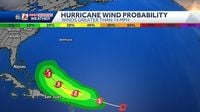As the 2025 Atlantic hurricane season enters its peak months, all eyes are on Tropical Storm Erin, a rapidly intensifying system that has already prompted warnings, travel disruptions, and widespread concern across the northern Caribbean and beyond. Erin, which formed just west of the Cabo Verde islands on August 11, has been gathering strength as it churns westward across the Atlantic, with forecasters expecting it to become the season’s first hurricane by Friday, August 15, and potentially escalate into a major Category 3 storm by the weekend.
Officials in the northern Caribbean, including those in Antigua and Barbuda, the U.S. and British Virgin Islands, and Puerto Rico, sounded the alarm on August 14, warning residents of the likelihood of heavy rains and dangerous swells as Erin approaches. According to the National Hurricane Center in Miami, the storm is projected to remain over open waters but will pass close enough to threaten these islands with tropical-storm-force winds and hazardous surf conditions during the weekend of August 16-17. Rain, gusty winds, and high surf are expected from Puerto Rico to Martinique, with the core of Erin passing just north of the northeast Caribbean islands.
“Erin is moving into an area of the Atlantic primed for rapid intensification. The waters are incredibly warm,” said Alex DaSilva, lead hurricane expert for AccuWeather, highlighting the environmental factors fueling the storm’s growth. As of late morning on August 14, Erin was located about 890 miles east of the northern Leeward Islands, with maximum sustained winds increasing from 50 mph to 60 mph, and moving west at approximately 17 mph. Meteorologists expect wind speeds to exceed 74 mph by Friday, marking Erin's transition to hurricane status.
Forecasters have been quick to note that Erin’s projected path has trended slightly westward and southward in recent days, which increases the chance of direct impacts for the northern Leeward Islands, the Virgin Islands, and Puerto Rico. While the core of the storm is expected to pass just north of these islands, the potential for heavy rain, gusty winds, and dangerous surf remains significant. The National Hurricane Center cautioned, “There is still a greater than normal uncertainty about what impacts Erin may bring to portions of the Bahamas, the east coast of the United States, and Bermuda in the long range.”
Hurricane specialist and storm surge expert Michael Lowry offered some reassurance, noting that “nearly all models have Erin turning safely east of the broader U.S. next week.” Still, the potential for high surf and dangerous rip currents along the U.S. East Coast is expected, regardless of whether the storm makes landfall. Bermuda, meanwhile, is being advised to monitor Erin’s progress closely, as the storm’s eventual turn to the north and northeast could bring it near the archipelago next week.
Erin’s formation and intensification come amid what experts are calling an unusually busy Atlantic hurricane season. The 2025 season, which began on June 1 and runs through November 30, has already produced five named storms, with forecasts from the National Oceanic and Atmospheric Administration (NOAA) predicting a total of 13 to 18 named storms, five to nine of which could become hurricanes. Up to half of those hurricanes are expected to reach major status—Category 3 or higher, with sustained winds of at least 111 mph.
The storm’s impact has already been felt far from its current location. In Cabo Verde, where Erin first formed, local media reported at least eight deaths due to flooding, prompting officials to declare a state of emergency as crews worked to address the damage. Drone footage posted to social media showed the aftermath of the flooding, underscoring the storm’s potential for devastation even at the early stages of its development.
As Erin advanced westward, its looming presence forced changes in travel plans and business operations. On August 14, Royal Caribbean announced a significant itinerary change for its cruise ship Vision of the Seas due to the approaching storm. The vessel, which departed Baltimore on a nine-night cruise, was originally scheduled for a two-day stop in Bermuda. Out of an abundance of caution, the Bermuda stop was canceled and replaced with a visit to Port Canaveral, Florida. The cruise will continue to Nassau and Royal Caribbean’s private island in The Bahamas, Perfect Day at CocoCay, as originally planned. The updated schedule reflects the cruise line’s commitment to passenger safety, a practice that, according to Cruise Fever, is standard during hurricane season: “It is rare that a cruise will get canceled due to a tropical storm or hurricane. Cruise lines do everything in their power to keep cruises sailing and their guests safe. This may mean a changed itinerary like today’s departure on Vision of the Seas.”
Despite Erin’s growing strength, cruise lines have made relatively few itinerary changes so far in 2025. The first three tropical storms of the season were short-lived and did not prompt widespread disruptions. However, the arrival of Erin—now the fifth named storm—serves as a stark reminder of the unpredictability of hurricane season and the need for constant vigilance among residents, travelers, and businesses in the region.
The Atlantic hurricane season typically peaks between August and October, and the current conditions—particularly the exceptionally warm waters of the Atlantic—are conducive to rapid storm development. As explained by weather.com, “Erin has reached warmer water that will allow the storm to strengthen into a hurricane late this week.” The combination of warm sea surface temperatures and low wind shear creates an environment ripe for storms to quickly intensify, sometimes leaving little time for communities to prepare.
Looking ahead, the longer-term path of Erin remains uncertain. Most forecast models suggest the storm will pivot to the northwest and then north as it encounters a developing break in high pressure between the eastern U.S. and east of Bermuda. This shift will likely steer Erin away from the U.S. mainland, but the possibility of impacts to Bermuda and the U.S. East Coast cannot be ruled out entirely. High surf and dangerous rip currents are anticipated along the East Coast next week, and authorities are urging residents to stay informed and heed local advisories.
For now, officials across the Caribbean and Atlantic basin are urging caution and close attention to official forecasts as Erin continues its march across the ocean. With the season’s busiest months still ahead, the story of Tropical Storm Erin is a vivid illustration of the challenges—and uncertainties—that come with living and traveling in hurricane-prone regions. As new information emerges and the forecast comes into sharper focus, communities from the Caribbean to Bermuda and the U.S. East Coast are bracing for whatever the next chapter in Erin’s journey may bring.
With the Atlantic churning and the season far from over, the region’s readiness and resilience will once again be put to the test as nature’s most formidable storms make their presence felt.






